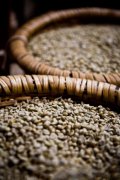Grading and classification of coffee beans
Coffee beans are graded first by size and then by density. With two exceptions, all coffee beans have a considerable size and the same proportion, with flat on one side and semi-oval on the other. The special cases are pea-shaped coffee beans that tend to be more oval in shape and giant coffee beans with large particles (that is, Marragol peel coffee beans). The prices of these two kinds of coffee beans are always higher.

Generally speaking, large coffee beans can produce better coffee. Coffee beans are usually graded on a scale of 10 to 20, but in some countries coffee beans are graded according to levels corresponding to a certain size, such as AA. The way to determine the size of coffee beans is to pass them through a sieve. But even so, there may be weight differences between coffee beans of the same size: and bad, crumpled coffee beans that have to be removed will still remain.
The best way to separate unwanted coffee beans from good ones is to use gravity and air. The compressed air method is operated manually and requires higher technology. it uses jets to separate heavy and light coffee beans. Another method, the weight separation separator, is to put the coffee beans on a raised plate and let the air pass through them to make the heavy coffee beans fall. This is also a technologically demanding method, if used properly, the coffee beans can be separated more accurately and effectively.
The next step is to sort these coffee beans. Remove rotten, black, sour and overfermented or unshelled coffee beans. This process depends on eyesight, putting the beans on a moving belt to check.
Other methods include the electronic color classification (mainly used for Robbaut coffee beans) and the dichromate (bichromatic) method, which uses light detection to find bad beans. Today, however, the best test classifier is still the human eye. But there is no doubt that high-tech microprocessing systems will eventually completely replace this process.
Coffee beans are graded in different countries according to different grading systems. Some of them, such as those commonly used in Haiti, are overly complex and ineffective, while the sorting devices used in Brazil, despite their complex structure, are indeed necessary. Overall, there are six export grades, the highest of which is SHB (strictly hardbean), or Highland Coffee beans, which are produced in highlands no less than 400m above sea level.
All coffee beans must be evaluated before they are purchased. The usual practice is to buy coffee beans for self-baking instead of roasting coffee beans that have already been roasted in the place of production. The main reason is that once the coffee beans are roasted, their shelf life will be short. The second reason is that most retailers in America and Europe like to buy coffee beans directly from local roasters so that they can better control the quality of their coffee.
Important Notice :
前街咖啡 FrontStreet Coffee has moved to new addredd:
FrontStreet Coffee Address: 315,Donghua East Road,GuangZhou
Tel:020 38364473
- Prev

The skill of grinding or shelling coffee beans
Coffee beans should be ground before they are exported, that is, the endocarp of Arabian and Robbite coffee beans to be sold should be removed. The residual shell of coffee beans after removal and cleaning of endocarp and drying process is also known as peeling or peeling. It is more difficult to remove the endocarp of coffee beans during wet treatment than during drying, so different methods are needed.
- Next

Eating fast food and drinking coffee are twice as harmful to blood sugar.
The pace of modern life is very fast, and many busy office workers often have a cup of coffee and a fast food for lunch. Drinking coffee while eating fast food can double the damage to blood sugar, according to a new study from Guihu University (University of Guelph) in Canada. The study was published in the journal Nutrition report. The study found that eating fast food high in saturated fat and drinking coffee at the same time
Related
- Beginners will see the "Coffee pull flower" guide!
- What is the difference between ice blog purified milk and ordinary milk coffee?
- Why is the Philippines the largest producer of crops in Liberia?
- For coffee extraction, should the fine powder be retained?
- How does extracted espresso fill pressed powder? How much strength does it take to press the powder?
- How to make jasmine cold extract coffee? Is the jasmine + latte good?
- Will this little toy really make the coffee taste better? How does Lily Drip affect coffee extraction?
- Will the action of slapping the filter cup also affect coffee extraction?
- What's the difference between powder-to-water ratio and powder-to-liquid ratio?
- What is the Ethiopian local species? What does it have to do with Heirloom native species?

